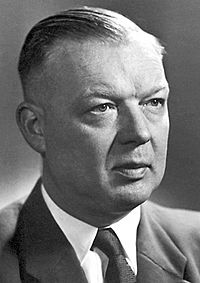Werner Forssmann facts for kids
Quick facts for kids
Werner Forßmann
|
|
|---|---|

Werner Forßmann
|
|
| Born |
Werner Theodor Otto Forßmann
29 August 1904 |
| Died | 1 June 1979 (aged 74) |
| Nationality | German |
| Alma mater | University of Berlin |
| Known for | Cardiac catheterization |
| Awards | Nobel Prize in Physiology or Medicine (1956) |
| Scientific career | |
| Fields | Medicine |
Werner Theodor Otto Forßmann was a German doctor and researcher. He is famous for a brave and risky experiment he did on himself. In 1929, he found a way to put a thin tube, called a catheter, directly into a person's heart. This was a huge step forward in medicine. It helped doctors learn more about the heart and treat heart problems. For his amazing work, he shared the Nobel Prize in Medicine in 1956 with two other scientists, Andre Frederic Cournand and Dickinson W. Richards.
Contents
Early Life
Werner Forßmann was born in Berlin, Germany, on August 29, 1904. He studied medicine at the University of Berlin. He finished his medical studies in 1929.
A Brave Idea
Forßmann had an idea that seemed very risky at the time. He thought a thin tube, called a catheter, could be put directly into the heart. This could help doctors give medicine, inject special dyes for X-rays, or measure blood pressure inside the heart.
At that time, most doctors believed putting anything into the heart would be deadly. But Forßmann was determined to prove his idea could work safely. He decided to try the experiment on himself.
The First Heart Catheterization
In 1929, Forßmann was working in a hospital in Eberswalde, Germany. He decided to perform the first human cardiac catheterization. He did this without his boss's permission.
He convinced a nurse, Gerda Ditzen, to help him. She agreed, but only if he did the experiment on her first. However, Forßmann tricked her. He tied her to the operating table and pretended to prepare her arm. But he actually gave himself a local anesthetic in his own arm.
He then inserted a thin tube, a urinary catheter, into a vein in his arm. He pushed the tube partly along the vein. Then he released the nurse, who realized the tube was in his arm, not hers. He told her to call the X-ray department.
Forßmann then walked to the X-ray room with the catheter still in his arm. Under the guidance of an X-ray machine, he slowly pushed the tube all the way into his right side of the heart. An X-ray picture was taken to prove the catheter was safely inside his heart.
After the Experiment
The head doctor at Eberswalde was very angry at first. But when he saw the X-rays, he realized how important Forßmann's discovery was. He allowed Forßmann to use the method on a very sick woman. Her condition improved after she received medicine directly into her heart this way.
For a while, Forßmann worked at a famous hospital in Berlin. But he was later dismissed because he had done his experiment without permission. Doctors at the time were very strict about such things.
It was hard for Forßmann to find a job in heart medicine after this. So, he decided to study and work in urology, which is the study of the urinary system. He became a specialist in that field.
Later Life and Recognition
From 1932 to 1945, Werner Forßmann was a member of a political party in Germany. During World War II, he served as a medical officer in the army. He was captured and held in a U.S. prisoner of war camp until 1945. After the war, he worked as a lumberjack for a short time. Then he became a country doctor with his wife. In 1950, he started working as a urologist again.
While Forßmann was a prisoner, his important paper about heart catheterization was read by two American doctors, André Frédéric Cournand and Dickinson W. Richards. They used his method to learn more about heart diseases and how to diagnose them.
In 1956, Forßmann, Cournand, and Richards were all awarded the Nobel Prize in Physiology or Medicine for their work on heart catheterization. This amazing honor brought Forßmann's pioneering work to worldwide attention.
After winning the Nobel Prize, Forßmann became an honorary professor at the University of Mainz in Germany. He also received many other honors from medical groups around the world.
Family Life
Werner Forßmann married Dr. Elsbet Engel, who was also a doctor specializing in urology. They had six children together: Klaus, Knut, Jörg, Wolf, Bernd, and Renate. Two of his sons, Wolf and Bernd, also became involved in medical research.
Werner Forßmann passed away in Schopfheim, Germany, on June 1, 1979, at the age of 74. His wife, Elsbet, died in 1993.
See also
 In Spanish: Werner Forssmann para niños
In Spanish: Werner Forssmann para niños
- André Frédéric Cournand
- Andreas Gruentzig
- Dickinson W. Richards

